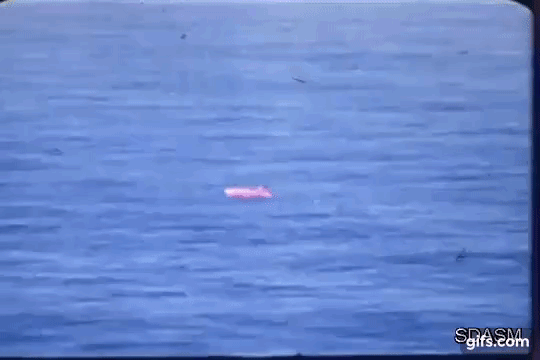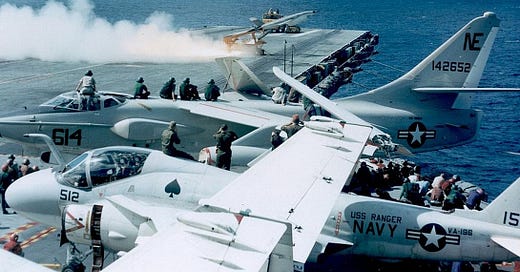The U.S. Navy Wanted to Send Drones on Anti-Ship Suicide Missions
An excerpt from 'Drone War: Vietnam’
The U.S. Navy was a big user of Ryan Aeronautical Q-2C target drones, and Navy carrier battle groups operating in the Gulf of Tonkin borrowed imagery from the U.S. Air Force’s operational Model 147 Lightning Bugs flying from Bien Hoa in South Vietnam.
By 1967 the Navy had decided it wanted front-line drones of its own. What follows is an excerpt from Drone War: Vietnam, my nonfiction book about the first drone war.
At first, the fleet wanted the Lightning Bug as a sort of fast-acting anti-cruise-missile platform. During the Six-Day War between Israel and its Arab neighbors in June 1967, Egyptian forces used a Soviet-made Styx cruise missile to sink the Israeli destroyer Elath, killing 49 sailors.
The sinking chilled U.S. Navy leaders. They imagined Soviet missiles overwhelming American ships in the event the Cold War turned hot. While ship-launched surface-to-air missiles were getting better by the month, these were defensive systems. The Navy wanted an offensive weapon that could strike Soviet ships before they could launch their own anti-ship missiles.
The Navy asked Ryan Aeronautical to develop a version of the Lightning Bug that could launch from a ship at sea while carrying an explosive warhead as heavy as 1,000 pounds and crash, kamikaze-style, into enemy vessels. Ryan Aeronautical dubbed the anti-ship drone the “Model 248.”
The anti-ship Lightning Bug required advancements in several subsystems. It needed a more powerful rocket booster to allow it to launch from the deck of a warship. It needed a highly accurate low-altitude radar altimeter. It required a T.V. camera in the nose that could feed a live image to a shipboard operator who could steer the drone to its aimpoint.
Between 1968 and 1971 the fleet separately tested the booster, the altimeter and the remote-control system on lightly-modified Q-2C targets. During one test off the California coast in September 1971, the drone flew so close to its target ship that it clipped a wire and exploded.

By 1971 the Model 248 was ready for a major investment. But the Navy demurred. The fleet also had been developing the Harpoon anti-ship cruise missile. Faced with a choice, the Navy opted to spend its dwindling development budget on the smaller and fully autonomous Harpoon.
The Navy got farther with recce drones. Around the same time the fleet launched development of the Model 248, it also began integrating unarmed Model 147s on aircraft carriers.
Carrier air wings didn’t operate aircraft large enough to launch the Model 147. They’d have to blast off directly from a carrier’s deck. While the military routinely launched Q-2C targets from land, the operational Model 147 strictly was air-launched.
So Ryan Aeronautical got to work modifying 10 Model 147SCs for deck-launch, adding a 15-feet-span wing and strapping a small rocket booster to the drones to help get them up to speed. A test launch in San Diego ended in embarrassment for Ryan Aeronautical when the drone flipped over and exploded not far from a watching admiral.
Trials moved to the carrier USS Bennington sailing off Southern California. The World War II-vintage flattop was an anti-submarine vessel. Its air wing included helicopters and slow-flying, propeller-driven sub-hunters. The pace of launches and landings was slow compared to the hectic activity aboard the attack carriers on Yankee Station in the Gulf of Tonkin.
The Navy laid down an extra steel plate on one of Bennington’s elevators in order to deflect the blast from the drone’s rocket booster. The first at-sea test was only slightly less embarrassing than was the ground test. The booster fired but the drone’s engine never fully spun up. The drone lobbed itself into the ocean off Bennington’s starboard side.
Subsequent tests went better. A Ryan Aeronautical team on Oct. 14, 1969 embarked on the attack carrier USS Ranger with three Model 147SKs. The carrier set sail for Yankee Station, pausing near Hawaii and again off The Philippines for training. The stop-overs also afforded the contractors an opportunity to bring aboard additional drones.
The plan was for a drone to launch from Ranger’s deck and recover by popping a ‘chute and descending into the sea near the carrier, which would dispatch a helicopter to fish the drone out of the water. There was no time to train the Navy ‘copter crews on the Air Force’s method of recovery.
Operators aboard one of the carrier’s E-2 radar early-warning planes would send commands via radio to steer the Lightning Bug to a checkpoint where the drone’s internal navigation system would take over.
Problems abounded. The carrier was too crowded and too busy for the sudden addition of a new and complex system. The E-2 crews were unfamiliar with the Model 147. The carrier tended to drift a few miles from its target station, skewing the drone’s navigational programming. The Lightning Bug crew had to launch its drone after Ranger launched a strike package and recover the drone before the package returned, leaving no room for error.
Of the first five front-line sorties in November 1969, just one was successful. The success rate picked up as 1969 turned to 1970. Model-147SK-5 in particular proved reliable and lucky. Until it wasn’t.
On Feb. 10, 1970 the drone launched from Ranger on its ninth and final mission. The E-2 crew sent command signals to the Lightning Bug, apparently without realizing that, in fact, they didn’t even have the drone on their radar scopes.
The admiral aboard Ranger grew frustrated. “Recover it!” he commanded. The operators pressed the button commanding the drone to pop its recovery parachute. As far as anyone knew, SK-5 was floating down to Earth. But no one knew where.
A few days later the Honolulu Star-Bulletin broke the news. The Chinese government had “shot down” an American drone over Hainan Island. In fact, the Chinese had simply snatched up the drone after it gently parachuted to the ground on Ranger’s command. The Lightning Bug enjoyed a period of notoriety as a major subject of Chinese propaganda.
Missions in April 1970 by and large were successful. The Lightning Bugs returned to Ranger with clear photos of SAM sites, anti-aircraft-artillery batteries, railways, highways and bridges.
Ranger flew her 28th and last Lightning Bug mission on May 10, 1970. The drone survived its run over North Vietnam but its recovery parachute failed to deploy. It disappeared beneath the Pacific waves. Ryan Aeronautical later concluded that saltwater corrosion had damaged the ‘chute mechanism.
And with that, all the Model-147SKs had been shot down, crashed, sank or delivered themselves into Chinese hands. The Navy declined to order more.
The consensus at Ryan Aeronautical was that the SKs would have worked better if the Navy had invested the time and money to develop a carrier-compatible mothership plane and a mid-air recovery system that worked with fleet helicopters. “The Navy got what it paid for,” Ryan Aeronautical contractor Dale Weaver said.
Drone War: Vietnam is out now from Pen & Sword Books.







